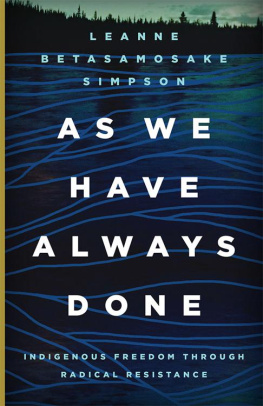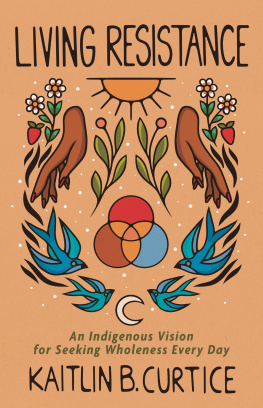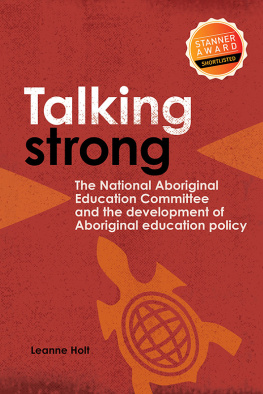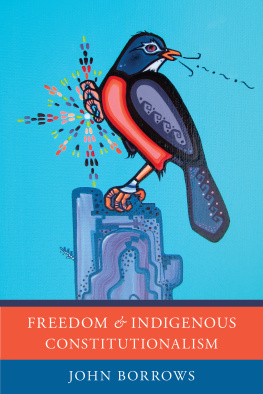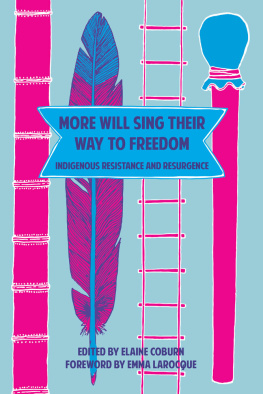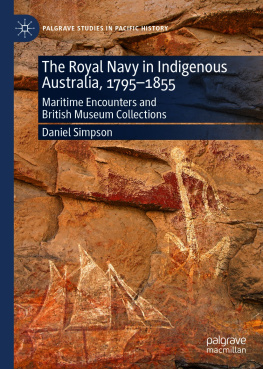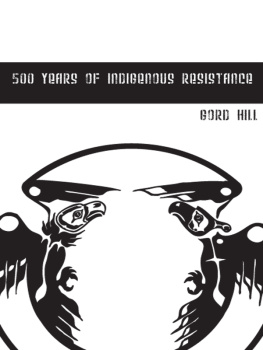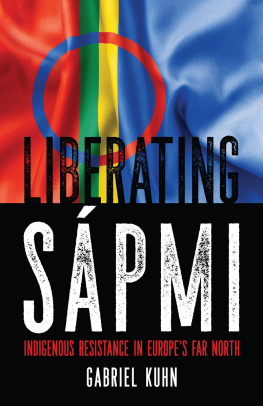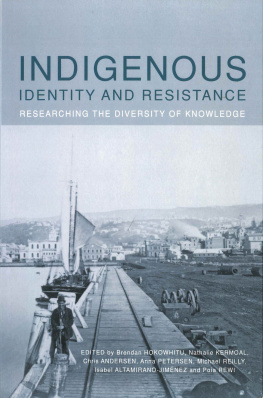Leanne Betasamosake Simpson - As We Have Always Done: Indigenous Freedom through Radical Resistance (Indigenous Americas)
Here you can read online Leanne Betasamosake Simpson - As We Have Always Done: Indigenous Freedom through Radical Resistance (Indigenous Americas) full text of the book (entire story) in english for free. Download pdf and epub, get meaning, cover and reviews about this ebook. year: 2017, publisher: University of Minnesota Press, genre: Politics. Description of the work, (preface) as well as reviews are available. Best literature library LitArk.com created for fans of good reading and offers a wide selection of genres:
Romance novel
Science fiction
Adventure
Detective
Science
History
Home and family
Prose
Art
Politics
Computer
Non-fiction
Religion
Business
Children
Humor
Choose a favorite category and find really read worthwhile books. Enjoy immersion in the world of imagination, feel the emotions of the characters or learn something new for yourself, make an fascinating discovery.
- Book:As We Have Always Done: Indigenous Freedom through Radical Resistance (Indigenous Americas)
- Author:
- Publisher:University of Minnesota Press
- Genre:
- Year:2017
- Rating:4 / 5
- Favourites:Add to favourites
- Your mark:
- 80
- 1
- 2
- 3
- 4
- 5
As We Have Always Done: Indigenous Freedom through Radical Resistance (Indigenous Americas): summary, description and annotation
We offer to read an annotation, description, summary or preface (depends on what the author of the book "As We Have Always Done: Indigenous Freedom through Radical Resistance (Indigenous Americas)" wrote himself). If you haven't found the necessary information about the book — write in the comments, we will try to find it.
As We Have Always Done: Indigenous Freedom through Radical Resistance (Indigenous Americas) — read online for free the complete book (whole text) full work
Below is the text of the book, divided by pages. System saving the place of the last page read, allows you to conveniently read the book "As We Have Always Done: Indigenous Freedom through Radical Resistance (Indigenous Americas)" online for free, without having to search again every time where you left off. Put a bookmark, and you can go to the page where you finished reading at any time.
Font size:
Interval:
Bookmark:
Indigenous Americas
Robert Warrior, Series Editor
Chadwick Allen, Trans-Indigenous: Methodologies for Global Native Literary Studies
Raymond D. Austin, Navajo Courts and Navajo Common Law: A Tradition of Tribal Self-Governance
Lisa Brooks, The Common Pot: The Recovery of Native Space in the Northeast
Kevin Bruyneel, The Third Space of Sovereignty: The Postcolonial Politics of U.S.Indigenous Relations
Glen Sean Coulthard, Red Skin, White Masks: Rejecting the Colonial Politics of Recognition
James H. Cox, The Red Land to the South: American Indian Writers and Indigenous Mexico
Brendan Hokowhitu and Vijay Devadas, The Fourth Eye: Mori Media in Aotearoa New Zealand
Daniel Heath Justice, Our Fire Survives the Storm: A Cherokee Literary History
Thomas King, The Truth about Stories: A Native Narrative
Scott Richard Lyons, X-Marks: Native Signatures of Assent
Aileen Moreton-Robinson, The White Possessive: Property, Power, and Indigenous Sovereignty
Jean M. OBrien, Firsting and Lasting: Writing Indians Out of Existence in New England
Shiri Pasternak, Grounded Authority: The Algonquins of Barriere Lake against the State
Steven Salaita, Inter/Nationalism: Decolonizing Native America and Palestine
Leanne Betasamosake Simpson, As We Have Always Done: Indigenous Freedom through Radical Resistance
Paul Chaat Smith, Everything You Know about Indians Is Wrong
Lisa Tatonetti, The Queerness of Native American Literature
Gerald Vizenor, Bear Island: The War at Sugar Point
Robert Warrior, The People and the Word: Reading Native Nonfiction
Robert A. Williams Jr., Like a Loaded Weapon: The Rehnquist Court, Indian Rights, and the Legal History of Racism in America
Leanne Betasamosake Simpson
Indigenous Americas

University of Minnesota Press | Minneapolis | London
The publication of this book was assisted by a bequest from Josiah H. Chase to honor his parents, Ellen Rankin Chase and Josiah Hook Chase, Minnesota territorial pioneers.
Title page art copyright Lianne Marie Leda Charlie
Our Treaty with the Hoof Nation and Binoojiinh Makes a Lovely Discovery were previously published in Leanne Betasamosake Simpson, The Gift Is in the Making, from the Debwe Series published by HighWater Press, 2013. Reprinted with permission.
The interview by Naomi Klein was previously published as Dancing the World into Being: A Conversation with Idle No Mores Leanne Simpson, Yes! Magazine, March 5, 2013. http://www.yesmagazine.org/peace-justice/dancing-the-world-into-being-a-conversation-with-idle-no-more-leanne-simpson.
Billy-Ray Bellcourt, sacred, was previously published at https://nakinisowin.wordpress.com/2016/02/26/sacred/. Reprinted with permission of the author.
Copyright 2017 by the Regents of the University of Minnesota
All rights reserved. No part of this publication may be reproduced, stored in a retrieval system, or transmitted, in any form or by any means, electronic, mechanical, photocopying, recording, or otherwise, without the prior written permission of the publisher.
Published by the University of Minnesota Press
111 Third Avenue South, Suite 290
Minneapolis, MN 55401-2520
http://www.upress.umn.edu
Library of Congress Cataloging-in-Publication Data
Names: Simpson, Leanne Betasamosake, author.
Title: As we have always done : indigenous freedom through radical resistance / Leanne Betasamosake Simpson.
Description: Minneapolis : University of Minnesota Press, 2017. | Series: Indigenous Americas | Includes bibliographical references and index. |
Identifiers: LCCN 2017037620 (e-book) | ISBN 978-1-4529-5601-5 (e-book)
Subjects: LCSH: Ojibwa IndiansPolitics and government. | Ojibwa IndiansCanadaGovernment relations. | Nishnawbe-Aski Nation.
Classification: LCC E99.C6 (e-book) | DDC 323.1197/333dc23
LC record available at https://lccn.loc.gov/2017022270
The University of Minnesota is an equal-opportunity educator and employer.
I AM WRITING THIS CHAPTER on a gray, wet winter day, in the caf in the sports complex at Trent University as my two kids attend swimming lessons. My kids pass the symbol with a casual they should change that and dont have a fit, Mom. They have grown up in their territory, learning with a community of artists, makers, and elders, a luxury that not all of us, including myself, have had. Because of that, I see a strength in them that I dont see in myself. I see an ability to point out and name colonialism, resist and even mobilize to change it. They know more about what it means to be Nishnaabeg in their first decades than I did in my third. This intimate resurgence in my family makes me happy.
Over a decade ago, I was listening to Doug speak to a group of Canadians in a coffee shop in downtown Peterborough, a city in central Ontario between Toronto and Ottawa. Peterborough is known to be a conservative hockey town (really, a small city) on the edge of cottage country. Doug wanted his audience to know where they were, and he began by telling them what the land used to look like. The non-Native audience was nearly silent, transfixed by each sentence he spoke. So was I, because as he was speaking, I was recognizing that the land I know as my home has been devastated by settlement, industrial development, the construction of highways and roads, the Trent-Severn Waterway, and four centuries of dispossession. I understood that the landscape I knew as home would be almost unrecognizable to my Ancestors, and I hadnt known previously that I could barely even imagine the worlds that had already been lost. In the weeks after that talk, I spoke with Doug about what he had shared. As we drove around our territory in the months that followed, he pointed out where the Wendat (Huron) villages used to be, where hunting grounds were located, the former locations of black oak savannas and tallgrass prairies. I began to start my own talks with a narrative of what our land used to look like as a quick glimpse, albeit a generalized one, of what was lostnot as a mourning of loss but as a way of living in an Nishnaabeg present that collapses both the past and the future and as a way of positioning myself in relation to my Ancestors and my relations. I want to do the same here in this book.
Nogojiwanong (the place at the end of the rapids, or Peterborough) is in the heart of the Michi Saagiig part of the Nishnaabeg nation, and we call our nation Kina Gchi Nishnaabeg-ogamigthe place where we all live and work together. between the Kanienkeh:ka (Mohawk) and the Michi Saagiig Nishnaabeg. Diplomatically, we have always had close ties to the Wendat. They asked to live in our territory at different points in history, and we made agreements with them so they could. There are wampum belts made, and the oral tradition has a lot of evidence that we lived together quite well: they lived in longhouses and farmed, and we were hunting and fishing, ricing and sugaring, traveling by the waterways.
Michi Saagiig Nishinaabeg are salmon people. Doug tells me ChiNiibish had its own resident population of salmon that migrated all the way to Stoney Lake to spawn. We drank directly from the lakes, and that was a good, healthy thing to do. There was a large population of eels that also migrated to Stoney Lake each year from the Atlantic Ocean. There was an ancient old-growth forest of white pine that stretched from Curve Lake down to the shore of Lake Ontario, which had virtually no understory except for a bed of pine needles. There were tallgrass prairies and black oak savannas where Peterborough stands today. The lakes were teeming with minomiin, or wild rice. The land was dotted with sugar bushes, the lakes were full of fish.
Font size:
Interval:
Bookmark:
Similar books «As We Have Always Done: Indigenous Freedom through Radical Resistance (Indigenous Americas)»
Look at similar books to As We Have Always Done: Indigenous Freedom through Radical Resistance (Indigenous Americas). We have selected literature similar in name and meaning in the hope of providing readers with more options to find new, interesting, not yet read works.
Discussion, reviews of the book As We Have Always Done: Indigenous Freedom through Radical Resistance (Indigenous Americas) and just readers' own opinions. Leave your comments, write what you think about the work, its meaning or the main characters. Specify what exactly you liked and what you didn't like, and why you think so.

